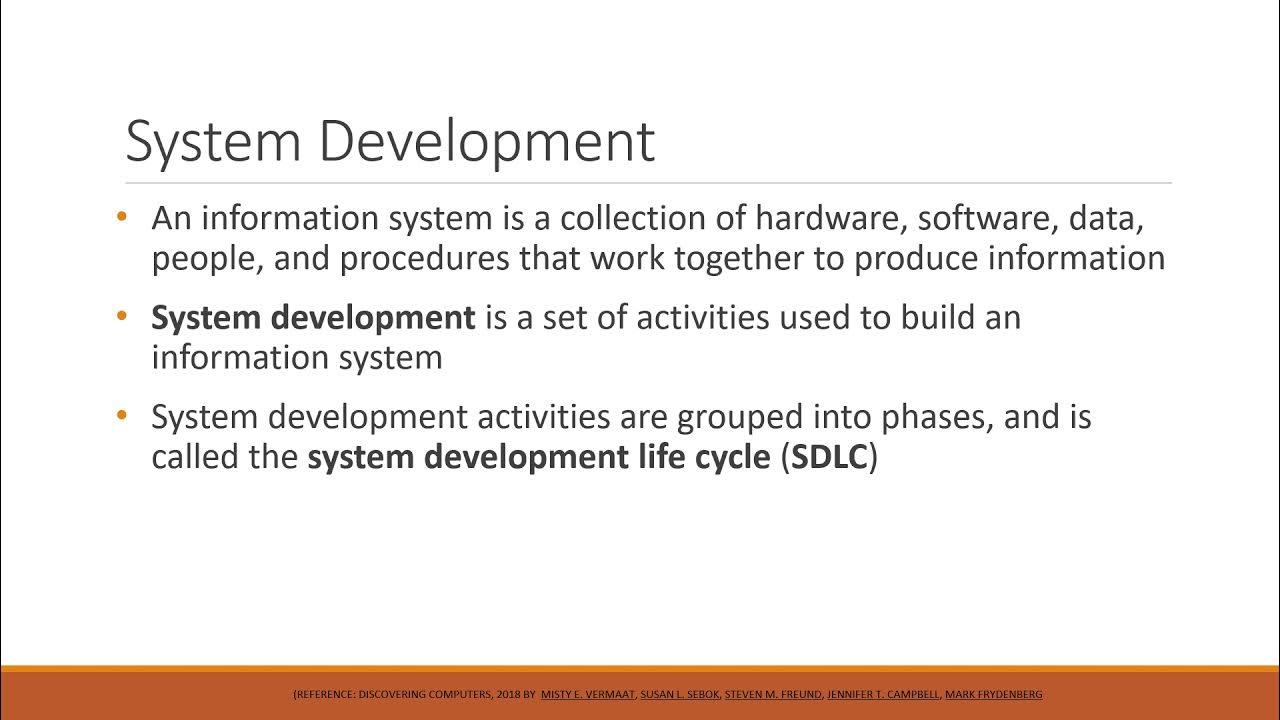03 Siklus Pengembangan Sistem
Summary
TLDRThis video explains the System Development Life Cycle (SDLC) in detail, outlining the key stages involved in developing an information system. It covers six main phases: Planning, System Analysis, System Design, System Selection, System Implementation, and System Maintenance. Each phase is described with its purpose, activities, and best practices, such as gathering requirements, designing user interfaces, testing, and ongoing system maintenance. Emphasizing collaboration between developers and management, the video provides a comprehensive understanding of how to build and maintain robust systems that meet organizational needs.
Takeaways
- 😀 The System Development Life Cycle (SDLC) involves several phases: planning, analysis, design, selection, implementation, and maintenance.
- 😀 Planning involves identifying and prioritizing which information systems to develop, and defining objectives, timelines, budgets, and resource requirements.
- 😀 System analysis focuses on gathering information from all stakeholders, not just administrators, to define the system's requirements and priorities.
- 😀 Communication between developers and management is essential to ensure alignment on the system's goals and functionality.
- 😀 The design phase includes both logical and physical designs, detailing data flow, processes, and technical specifications like software, hardware, and network requirements.
- 😀 The selection phase evaluates different solutions based on cost, performance, and technical feasibility, and recommends the best alternative for the system.
- 😀 Implementation involves building the system, testing it to ensure it works properly, and installing it for use by the organization.
- 😀 System testing ensures the program is error-free, that data updates correctly, and that it meets user requirements.
- 😀 After implementation, maintenance is crucial for system longevity, addressing issues, optimizing performance, and scaling infrastructure as necessary.
- 😀 Each phase of SDLC involves an iterative process, where solutions are refined based on feedback from users, developers, and management to meet evolving business needs.
Q & A
What is the purpose of the planning phase in system development?
-The planning phase aims to identify and prioritize the information systems to be developed, define the goals, set the timeline, allocate resources, and determine who will be responsible for executing the project.
How does system analysis differ from the planning phase?
-System analysis focuses on gathering and analyzing user requirements, defining priorities, and identifying the system’s needs from multiple departments. In contrast, the planning phase is about outlining the overall strategy and ensuring the availability of resources.
What is meant by 'system requirements' in the analysis phase?
-System requirements refer to the needs and expectations of all relevant stakeholders, such as different departments or users. This includes functional requirements (what the system must do) and non-functional requirements (how the system should perform, like speed and security).
Why is it important to analyze the needs of all departments in system analysis?
-Analyzing the needs of all departments ensures that the system will integrate smoothly across the organization. It helps identify interdependencies and avoid siloed solutions that may not meet the needs of all users.
What does logical system design involve?
-Logical system design focuses on the functional aspects of the system, such as defining data flow, processes, and user interfaces. It describes how the system will operate at a conceptual level, without diving into technical specifications.
What is the role of physical system design?
-Physical system design involves the technical specifications for hardware, software, and network infrastructure needed to implement the system. This phase focuses on selecting technologies, platforms, and ensuring the necessary equipment and resources are available.
What is the purpose of the system selection phase?
-The system selection phase involves evaluating different design alternatives, weighing the costs and benefits of each option, and selecting the most suitable one based on factors like performance, scalability, and financial considerations.
How does system implementation ensure the system meets user needs?
-During system implementation, the system is built and tested to ensure it performs as expected. User acceptance is confirmed through testing and feedback, making sure the system aligns with user requirements and expectations.
What are the key activities involved in system testing during implementation?
-System testing involves checking if the system works as expected under various conditions. This includes validating functions like data entry, processing, and output generation, as well as ensuring error-free operation and system stability.
Why is system maintenance necessary after implementation?
-System maintenance ensures that the system continues to function effectively over time. It addresses issues like system updates, data growth, performance optimization, and adapting to new user needs or technology changes.
Outlines

هذا القسم متوفر فقط للمشتركين. يرجى الترقية للوصول إلى هذه الميزة.
قم بالترقية الآنMindmap

هذا القسم متوفر فقط للمشتركين. يرجى الترقية للوصول إلى هذه الميزة.
قم بالترقية الآنKeywords

هذا القسم متوفر فقط للمشتركين. يرجى الترقية للوصول إلى هذه الميزة.
قم بالترقية الآنHighlights

هذا القسم متوفر فقط للمشتركين. يرجى الترقية للوصول إلى هذه الميزة.
قم بالترقية الآنTranscripts

هذا القسم متوفر فقط للمشتركين. يرجى الترقية للوصول إلى هذه الميزة.
قم بالترقية الآنتصفح المزيد من مقاطع الفيديو ذات الصلة
5.0 / 5 (0 votes)






